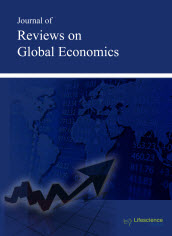jrge
Abstract - Spatial Interaction Regional Model for the Mexican Economy (SIRMME): A Special Case for Mexico City Metropolitan Area
|
|
Abstract: This paper analyzes empirically a macro model and a regional model to explain Mexico and Mexico City economies respectively. Typically, regional economic modeling considers either a top-down or bottom-up approach to model regional difference in economic growth. This paper shows results that explain regional difference in Mexico from the bottom-up through a special case that focuses on the spatial interaction between Mexico City -the main economic engine of Mexico- and the rest of the country during the period 2000-2010. Our results indicate that variables associated with human capital, internal migration, "creative class", micro-firms and spatial interaction among micro-regions were conditioning the differential growth between Mexico City and the whole country during the period 2000-2010. Likewise, we present econometric results of a typical macro model that explains economic growth in Mexico by different income effects on components of aggregate demand during the period 1993-2010. The purpose of both exercises is to motivate future research for the Mexican case to link macro components (such as export driven forces, Mexico´s dependency to the USA´s business cycle, loss of government spending, etc.) with their local counterparts such as agglomeration economies, human and creative capital stock, regional spillovers, natural resources, dynamic population, etc. to explain regional differential growth. Keywords: Spatial regional model, differential regional growth, simulation forecasting, Mexican economy, Mexico City Metropolitan Area.Download Full Article |
Abstract - Testing for Pro-Poorness of Growth through the Tax System: The Mexican Case
|
|
Abstract: This research provides a detailed examination of the redistributive effect achieved by the tax system including total taxes and cash transfers targeting the contributors and households in the period 2002-2008-2014 for the Mexican regions and the country. We measure the impact on income growth through the tax system according to each fiscal rules for the corresponding years using pre and post fiscal conditions. We answer the next question: considering the economic growth on per capita incomes in the Mexican states, will the impact of the Mexican tax system improve income distribution? That is, by all means pro-poor? Our methodology allows to detect if taxes and benefits can really induce an improvement of income growth on the regions captured by its wellbeing and economic growth conditions. We outlined relevant theoretical issues on public fiscal policies concerning this work and lastly, we proceed with an empirical application to develop some recommendations for the Mexican fiscal policy system. Keywords: Fiscal policy, pro-poor regional growth, redistribution, progressivity.Download Full Article |
Abstract - The Long-Run Relationship among Health and Income in Mexico, 1940-2011
|
|
Abstract: Theoretically, it has been argued the existence of not only a strong positive correlation among health and real per capita income, but also that their variations are highly interconnected. The stationarity among health indicators and income is analyzed for Mexico, allowing for the presence of multiple structural breaks along 1940-2011, with the aim to study its long-run relationship and how the reductions of the public expenditure have affected this link. One novelty is the long-run perspective supported on structural breaks that affect both the level and the slope of the time series. After the serial correlation is accounted for, several stationary processes evolving around a broken trend are found. The estimated breakpoints are widely related to events as crises and health system reforms, while the corresponding regimes changes lead to a stage of minor health expenditure. This last can be of concern to government and society if improvements on health and economic development are desired. Keywords: Health economics, per capita income, cointegration, unit roots, structural breaks.Download Full Article |
Abstract - An Exploration of Regional Labor Productivity Patterns of Manufacturing SMEs in Mexico
|
|
Abstract: The goal of this paper is to characterize the small and medium-sized enterprises (SMEs) in Mexico by analyzing regional and industrial labor productivity growth differences in the manufacturing sector during the period 2004-2014. The results suggest that labor productivity differs according to the size of the establishment. While microenterprises and small establishments exhibit a moderate increase, medium- and large-sized establishments experience the largest increase during such period. The empirical analysis indicates the existence of absolute and conditional convergence in productivity growth for the SMEs. Industry differences across locations seem to be an important factor although regional differences account for the greater variation in productivity growth. Keywords: Convergence, SMEs, economic growth.Download Full Article |
Abstract - Fiscal Policy and Economic Performance: A Review
|
|
Abstract: The economic implications of government expenditure have been shown to be significant and broad. In particular, government spending has been shown to enhance long-run economic growth by increasing the level of human capital and Research and Development (R&D) expenditure, and by improving public infrastructure. On the other hand, there is evidence that a greater size of government spending may be less efficient and therefore not necessarily associated with a better provision of public goods and higher levels of economic growth. Moreover, it is likely that the size of government expenditure and its composition are associated with key aspects of the quality of growth, such as income inequality and environmental sustainability. This paper presents a review of the theoretical and empirical literature on the relationship between fiscal policy and economic activity, both in terms of long-run economic growth and short-term output fluctuations. In general, empirical evidence on these relationships is not robust and remains inconclusive. Keywords: Fiscal policy, Economic growth, Government Expenditure, Taxation.Download Full Article |



